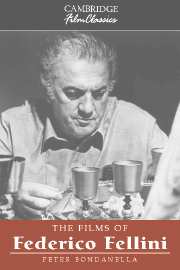Book contents
- Frontmatter
- Contents
- List of Illustrations
- Introduction
- 1 Federico Fellini: A Life in the Cinema
- 2 La strada: The Cinema of Poetry and the Road beyond Neorealism
- 3 La dolce vita: The Art Film Spectacular
- 4 8½: The Celebration of Artistic Creativity
- 5 Amarcord: Nostalgia and Politics
- 6 Intervista: A Summation of a Cinematic Career
- Notes
- Selected Bibliography on Federico Fellini
- A Fellini Filmography: Principal Credits
- List of Additional Films Cited
- Index
1 - Federico Fellini: A Life in the Cinema
Published online by Cambridge University Press: 12 January 2010
- Frontmatter
- Contents
- List of Illustrations
- Introduction
- 1 Federico Fellini: A Life in the Cinema
- 2 La strada: The Cinema of Poetry and the Road beyond Neorealism
- 3 La dolce vita: The Art Film Spectacular
- 4 8½: The Celebration of Artistic Creativity
- 5 Amarcord: Nostalgia and Politics
- 6 Intervista: A Summation of a Cinematic Career
- Notes
- Selected Bibliography on Federico Fellini
- A Fellini Filmography: Principal Credits
- List of Additional Films Cited
- Index
Summary
When Federico Fellini died on 31 October 1993, he had reached the pinnacle of international success. In April of that year, the American Academy of Motion Pictures and Sciences had honored him with a lifetime achievement, an Honorary Award for his entire career. This was his fifth Oscar, after earlier awards in the category of Best Foreign Film for La strada (1954), Le notti di Cabiria (The Nights of Cabiria, 1957), 8½ (1963), and Amarcord (1973), not to mention numerous nominations and awards in the technical categories for a number of films. Similar lifetime-achievement awards had earlier been given to Fellini in 1974 by the Cannes Film Festival, and in 1985 by both the Venice Biennale and the Film Society of Lincoln Center. On Broadway, Fellini films inspired important musicals: The Bob Fosse–directed Sweet Charity (1965; film 1969) was based upon Le notti di Cabiria, whereas Fosse's Nine (1981) and earlier film All That Jazz (1979) both owed their origins to Fellini's masterpiece, 8½. References to Fellini or direct citations of his work are found in a wide variety of films by very different directors: Lina Wertmüller's Pasqualino Settebellezze (Seven Beauties, 1976), Woody Allen's Stardust Memories (1980) or The Purple Rose of Cairo (1985), Giuseppe Tornatore's Nuovo Cinema Paradiso (Cinema Paradiso, 1988) and L'uomo delle stelle (The Star Maker, 1996), or Joel Shumacher's Falling Down (1993). Television commercials for various products have frequently employed parodies of Fellini's style.
In 1992, a Sight and Sound poll asked two groups of individuals for their estimations of which film directors and which films represented the most important creative artists or artistic works during the century-old history of the cinema.
- Type
- Chapter
- Information
- The Films of Federico Fellini , pp. 7 - 42Publisher: Cambridge University PressPrint publication year: 2002



